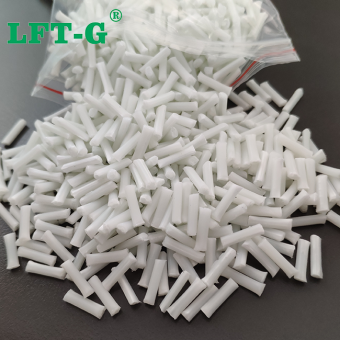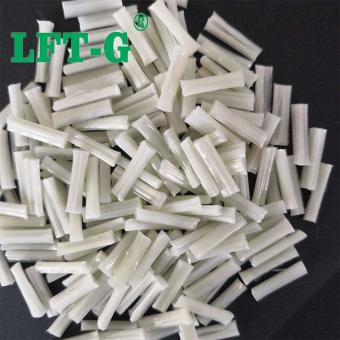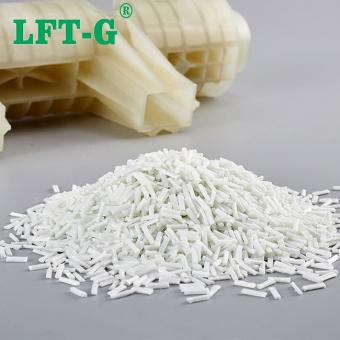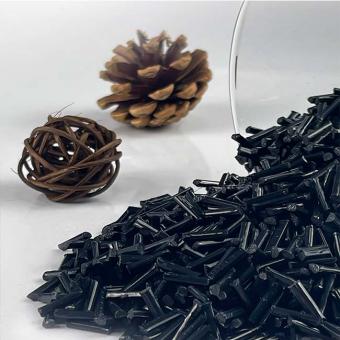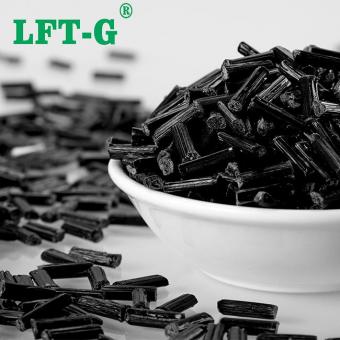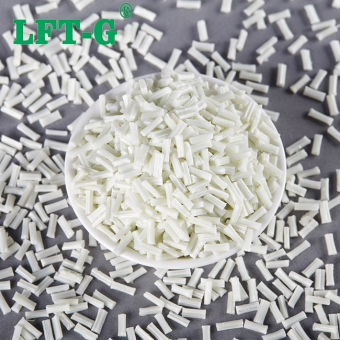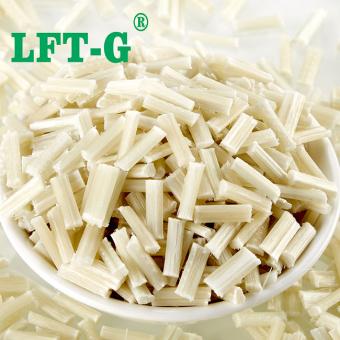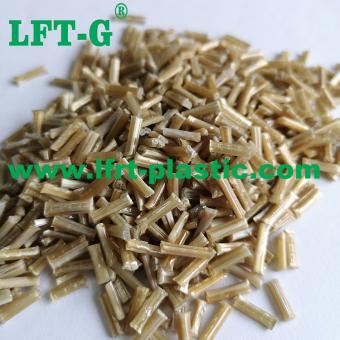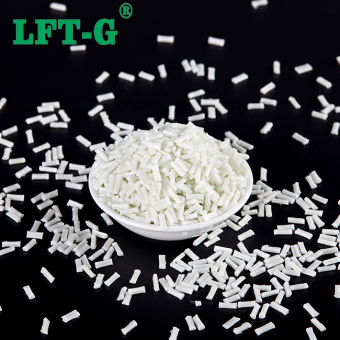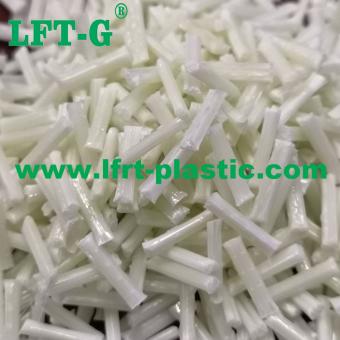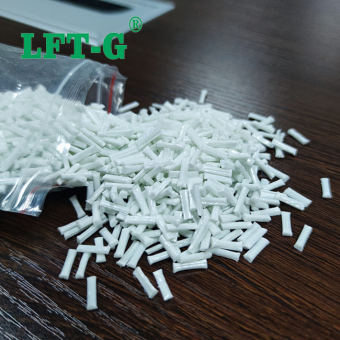-
Xiamen LFT-G Acrylonitrile Butadiene Styrene ABS filling long glass fiber modified plastic 12mmWhat is ABS? ABS (ABS is the acronym of Acrylonitrile Butadiene Styrene copolymer), also known as ABS resin, is a kind of thermoplastic polymer structural material with high strength, good toughness and easy to be machinated. ABS engineering plastic appearance is opaque ivory grain, its products can be colorful, and has high gloss. Why filling Long glass fiber? LFT & LFRT, Long fiber reinforced thermoplastic engineering plastics, compared to conventional short fiber reinforced thermoplastis, typically have a fiber length of less than 1 to 2 mm in conventional short fiber reinforced thermoplastics, while the LFT process the thermoplastic engineering plastics produced have been able to maintain fiber lengths above 5 to 25 mm. The long fiber is impregnated with a specail resin system to obtain a long strip which is suffciently wetted by the resin, and then cut into a desired length as required. According to the final different applications, the finished product can be used foe injection molding, extrusion and molding, Etc., directly used to replace steel and thermoset products. Advantages of ABS-LGF 1 glass fiber reinforced, glass fiber is a high temperature resistant material, therefore, the heat resistant temperature of reinforced plastic is much higher than before without glass fiber, especially nylon plastics. 2. After glass fiber reinforcement, due to the addition of glass fiber, the mutual movement between polymer chains of plastic is limited, therefore, the shrinkage rate of reinforced plastics decreases a lot, and the rigidity is greatly improved. 3. After glass fiber reinforcement, reinforced plastics will not stress crack, at the same time, the anti-impact performance of plastics is improved a lot. 4. After glass fiber reinforcement, glass fiber is a high strength material, which also greatly improves the strength of plastic, such as: tensile strength, compression strength, bending strength, improve a lot. 5. glass fiber reinforced after, due to the addition of glass fiber and other additives, the combustion performance of reinforced plastics decreased a lot, most of the material can not ignite, is a kind of flame retardant material. Datasheet for reference Application of ABS-LGF Mainly used in load-bearing parts and structural parts Details you may wonder Number Length Color MOQ Package Sample Delinery time Port of Loading ABS-NA-LGF30 5~25MM above Original color (can be customized) 25kg 25kg/bag Available 7~15 days after shipment Xiamen Port Our company Our teams & customers We will offer you: 1. LFT&LFRT material technical parameters and leading edge design. 2. Mold front design and recommendations. 3. Provide technical support such as injection molding and extrusion molding.
- long glass fiber Acrylonitrile Butadiene Styrene
- long fiber compounds ABS
- long fiber composite ABS granules
- long fibre reinforced thermoplastics
- ABS LGF30
- abs glass fiber
Tags :
-
Xiamen LFT-G Polyamide 6 Long Glass Fiber Reinforced Thermoplastic for automotive partsProduct grade: General grade, Toughen resistant grade Fiber specification: 20%-60% Product feature: High toughness, Low warpage, Light texture, etc Product application: Automotive, Electronic appliances, Sports equipment, Power tools, etc.
- High performance nylon 6 LGF
- Good appearance LFT materials polyamide 6
- 2023 Hot sell GF made in China pa6 modified plastic
- Supplier price better mechanical properties
- Sample provide car parts long cut piece fiber
- Good price high-strength components materials PA6 injection compounds
Tags :
-
Xiamen LFT-G PLA Polylactic Acid filling long glass fiber thermoplastic original colorWhat is PLA material? Polylactic acid (PLA) is a new bio-based and renewable biodegradable material made from starch extracted from renewable plant resources such as maize and cassava. Starch raw materials through saccharification to obtain glucose, and then from the glucose and a certain strain fermentation into high purity lactic acid, and then through chemical synthesis of a certain molecular weight of polylactic acid, the polymerization chain is as follows. Starch (refined) -- - > glucose (fermentation) -- - > lactic acid (cyclic) -- - > lactide (polymerization) -- - > the PLA PLA is the "green plastic" with the greatest development potential in the 21st century. It has good mechanical properties and transparency, but its shortcomings such as slow crystallization rate and poor heat resistance limit its popularization and use. Therefore, some toughening method is often used to enhance its performance, but at the expense of transparency or complex process. What is PLA LGF material? The rigidity of the fiber makes it play the role of skeleton support in the polymer matrix. When the polymer is heated, the movement of the chain segment is limited, thus improving the heat resistance of the material At present, carbon fiber and glass fiber can be used to enhance the modification of PLA. Among these fibers, carbon fiber and glass fiber are widely used because of their high strength and modulus. The composite material was prepared by adding fiber into PLA. After heat treatment, the modification effect of the composite material was the best, and the heat resistance temperature was increased by nearly 40℃ compared with that of pure PLA. Two or more materials with synergistic effect can be added at the same time to improve the thermal performance of PLA. The test results show that the Vica softening temperature of the composites exceeds 140℃. Production process Details Other products you may wonder PP-LGF PA6-LGF TPU-LGF Frequently asked questions Q. Does long glass fiber and long carbon fiber injection have special requirements for injection molding machines and molds? A. There are certainly requirements. Especially from the product design structure, as well as the injection molding machine screw nozzle and mold structure injection molding process must consider the requirements of long fiber. Q. The product is easy to brittle, so changing to use long fiber reinforced thermoplastic materials can solve this problem? A. The overall mechanical properties must be improved. The characteristics of long glass fiber and long carbon fiber are the advantages in mechanical properties. It has 1-3 times higher (toughness) than short fiber, and the tensile strength (strength and rigidity) is increased by 0.5-1 times. Q. When a customer want to develop a new product, how to recommend customers suitable material and characteristics? A. It is necessary to understand the customer's technical requirements, use environment, test conditions for the new product, and recommend the model according to various kind of long-fiber resin substrate characteristics.
- long glass fiber Polylactic acid
- LGF injection molding PLA compounds
- PLA green materials GF can be recycled
- high rigidity glass filled pla filament composite
- glass filled pla high performance
- made in China self factory home appliances
Tags :
-
Xiamen LFT Polyamide 6 CFRP composite long carbon fiber for manufacturing helmetsPA6 raw material Polyamide 6, also known as polycaprolactam or nylon 6(PA6), is a semi-transparent to opaque yellowish or milky white thermoplastic resin. The relative density of PA6 is 1.12~ 1.14g /cm3, the melting point is 219~225℃, the tensile strength is 68~83MPa, the compression strength is 82~88MPa, the low temperature resistance is good (-75℃ is not brittle), the wear resistance, self-lubricating and oil resistance is good. Due to the excellent structure and properties of PA6, more and more researchers at home and abroad have carried out important research and development on PA6, including exploring new polymerization chemicals for production, changing its structure and properties, and finding new processing methods, etc. PA6-LCF Long carbon fiber (LCF) reinforced nylon composites with high specific strength, high specific modulus, high temperature resistance and other excellent properties, expand the application space of nylon high technology field, is one of the most important reinforced composites at present. TDS Tested by us, for reference only. Application Injection technology About us Come and contact us now!
- PA6 long carbon fiber high mechanical properties
- PA6 LCF produer high performance
- Nylon 6 composite materials
- injection molding industrial plastic
- PA6 resin composites compounds
- compond plastic thermoplastic resin good price NYLON
Tags :
-
Xiamen LFT Polypropylene filling long carbon fiber composites PP higher toughness and strengthLong Carbon Fiber Reinforced Polymer (LCFRP) is composed of carbon fiber as the reinforcement material and resin as the matrix material
- Polymeric compounds thermoplastic resin
- White waxy material can be customized compounds
- Thermoplastic synthetic resin injection molding PP instead metal
- polymer PP polypropylene CFRP black carbon filament
- Translucent solid material reinforced plastic
- Industrial use for automotive parts car
Tags :
-
Xiamen LFT-G Nylon 6 Polyamide 6 composite Long Glass Fiber modified plastic 12mm original colorPA6 material PA6 is one of the most widely used materials in the current field, and PA6 is a very good engineering plastic with balanced and good performance. The raw materials for the manufacture of nylon 6 engineering plastic are extensive and inexpensive, and it is not restricted by the technological monopoly of foreign companies. However, in order to make good use of this inexpensive and excellent material, we must first understand it. Today, we will start with glass fiber reinforced PA6 engineering plastics, because it is the most important category of PA6 engineering plastics. Just like any other engineering plastics, PA6 has advantages and disadvantages, such as high water absorption, low temperature impact toughness and dimensional stability is relatively poor. So engineers will use different methods to make PA6 better, which we call modification. At present, the most common method is to blend and modify PA6 with glass fiber (GF). Today, we will take a look at the mechanical properties of PA6 engineering plastics under the glass fiber GF system for reference and help us select materials. PA6-LGF 1. Influence of glass fiber content on PA6 engineering plastics We can find from the application and experiment that the content index is often one of the biggest influencing factors in fiber reinforced composites. As the glass fiber content increases, the number of glass fibers per unit area of the material will increase, which means that the PA6 matrix between the glass fibers will become thinner. This change determines the impact toughness, tensile strength, bending strength and other mechanical properties of glass fiber reinforced PA6 composites. In terms of impact performance, the increase of glass fiber content will greatly increase the notch impact strength of PA6. Taking long glass fiber (LGF) filling PA6 as an example, when the filling volume increases to 35%, the notch impact strength will increase from 24.8J/m to 128.5J/m. But the glass fiber content is not more is better, short glass fiber (SGF) filling volume reached 42%, the impact strength of the material reached the highest 17.4kJ/㎡, but continue to add will let the gap impact strength showed a downward trend. In terms of bending strength, the increase of the amount of glass fiber will make the bending stress can be transferred between the glass fiber through the resin layer; At the same time, when the glass fiber is extracted from the resin or broken, it will absorb a lot of energy, thus improving the bending strength of the material. The above theory is verified by experiments. The data show that the bending elastic modulus increases to 4.99GPa when the LGF (long glass fiber) is filled to 35%. When the content of SGF (short glass fiber) is 42%, the bending elastic modulus reaches 10410MPa, which is about 5 times that of pure PA6. 2. Influence of glass fiber retention length on PA6 composites The fiber length of the glass fiber also has an obvious effect on the mechanical properties of the material. When the length of the glass fiber is less than the critical length (the length of the fiber when the material has the tensile strength of the fiber), the interface binding area of the glass fiber and the resin increases with the increase of the length of the glass fiber. When the composite material is broken, the resistance of the glass fiber from the resin is also greater, so as to improve the ability to withstand the tensile load. When the length of glass fiber exceeds the critical, the longer glass fiber can absorb more impact energy under impact load. In addition, the end of the glass fiber is the initiation point of crack growth, and the number of long glass fiber ends is relatively less, and the impact strength can be significantly improved. The experimental results show that the tensile strength of the material increases from 154.8MPa to 164.4MPa when the glass fiber content is kept at 40% and the length of the glass fiber increases from 4mm to 13mm. The bending strength and notched impact strength increased by 24% and 28%, respectively. Moreover, the research shows that when the original length of the glass fiber is less than 7mm, the material performance increases more obviously. Compared with short glass fiber, long glass fiber reinforced PA6 material has better appearance warping resistance, and can better maintain mechanical properties under high temperature and humidity conditions. TDS for your reference PA6 can be made into long glass fiber reinforced material by adding 20%-60% long glass fiber according to the characteristics of the product. PA6 with long glass fiber added has better strength, heat resistance, impact resistance, dimensional stability and warping resistance than without glass fiber added. Following TDS show the data of PA6-LGF30. Application PA6-LGF has the largest proportion of applications in the automotive industry, by electronic and electrical applications, and also involving machinery and engineering ...
- PA6 thermoplastic resin materials
- nylon 6 granules
- glass fiber reinforced plastics granules
- long fiber compounds pa6
- Injection molding plastic
- LFT-G reinforced material
Tags :
-
Xiamen LFT HDPE filling long glass fiber composite plastic lgf high toughness for structural partsWhat is HDPE? High density polyethylene (HDPE) is a white powder or granular product. Non-toxic, tasteless, crystallinity is 80% ~ 90%, softening point is 125 ~ 135℃, the use of temperature can reach 100℃; The hardness, tensile strength and creep property are better than low density polyethylene. Good wear resistance, electrical insulation, toughness and cold resistance; Good chemical stability, at room temperature, insoluble in any organic solvent, acid, alkali and all kinds of salt corrosion resistance; Thin film to water vapor and air permeability is small, low water absorption; Poor aging resistance, environmental stress cracking resistance is not as good as low density polyethylene, especially thermal oxidation will reduce its performance, so the resin must be added in antioxidants and ultraviolet absorbent to improve this deficiency. Filling Long glass fiber The tensile strength of polyethylene can be improved obviously when the amount of glass fiber is 30% ~ 40%. With the continuous increase of the addition amount, the increase of tensile strength did not change significantly, but tended to be stable. The addition amount of glass fiber has a great influence on the elastic modulus of polyethylene plastic materials. With the increase of glass fiber addition amount, the elastic modulus of polyethylene plastic materials will continue to increase and reach a certain value. The addition of glass fiber has a great effect on the elongation at break of polyethylene plastic materials. With the increase of the addition of glass fiber, the elongation at break of polyethylene plastic materials will continue to decrease. Up to a certain value, the brittleness of glass fiber modified polyethylene will be more obvious, almost equal to glass fiber brittleness. TDS for your reference Application Factory Warehouse & Package Teams & Customers We will offer you: 1. LFT & LFRT material technical parameters and leading edge design. 2. Mold front design and recommendations. 3. Provide technical support such as injection molding and extrusion molding.
- long glass fiber High density polyethylene
- long fiber compounds HDPE
- HDPE LFT
- HDPE long fiber pellet
- Glass fiber HDPE
Tags :
-
LFT-G PPS Polyphenylene sulfide LGF composite long glass fiber customized engineering plasticsWhat is the PPS? Polyphenylene sulfide (PPS) is a new thermoplastic resin with high performance. By filling, modified with excellent high temperature resistance, corrosion resistance, wear resistance, flame retardant, balanced physical and mechanical properties and excellent dimensional stability and excellent electrical properties and other characteristics of the new high performance thermoplastic resin, as well as high mechanical strength, chemical resistance, flame resistance, good thermal stability, excellent electrical properties and other advantages. It has the advantages of hard and brittle, high crystallinity, inflammability, good thermal stability, high mechanical strength, excellent electrical properties, strong chemical corrosion resistance and so on. The mechanical properties of pure PPS are not high, especially the impact strength is relatively low. Good creep resistance under load, high hardness; High wear resistance, the wear at 1000 RPM is only 0.04g, and will be further improved after filling F4 and molybdenum disulfide; It also has a certain degree of self-moistening. The mechanical properties of PPS are less sensitive to temperature. What is the PPS-LGF? PPS is one of the best varieties of heat resistance in the engineering plastic department. The thermal deformation temperature of the material modified by glass fiber is generally greater than 260 degrees, and the chemical resistance is second only to PTFE. In addition, it also has small shrinkage, low water absorption, good fire resistance. Good resistance to vibration fatigue, strong resistance to arc, especially at high temperature. Excellent electrical insulation in high humidity. But its disadvantages are brittleness, toughness, low impact strength, after modification, can overcome the above shortcomings, obtain very excellent comprehensive performance. As a plastic, its properties and uses far exceed those of ordinary plastics, and in many ways it is as good as metal materials. Excellent material PPS has the advantages of high temperature corrosion resistance, excellent mechanical properties, can replace metal including stainless steel, copper, aluminum, alloy, etc., is considered to be the best substitute for metal, copper. What is the application of PPS-LGF? PPS is now widely used in automotive, aerospace, household appliances, mechanical construction and chemical industry for a variety of structural parts, transmission parts, insulation parts, corrosion resistant parts and seals. Under the condition of ensuring sufficient strength and other properties, the weight of the product is greatly reduced. Datasheet for reference Details Number Color Length MOQ Package Sample Delivery time Port of Loading PPS-NA-LGF30 Original color (can be customized) 5-25mm above 25kg 25kg/bag Available 7-15 days after shipment Xiamen Poer Production process Trademarks and patents Teams and customers We will offer you: 1. LFT & LFRT material technical parameters and leading edge design 2. Mold front design and recommendations 3. Provide technical support such as injection molding and extrusion molding.
- PPS Long glass fiber 40
- pps compounds lgf
- pps resin materials lft
- lft-g pps reinforced plastic
- long glass fiber filling pps
- termoplastic resin pps lgf
Tags :
-
Xiamen LFT-G Polyamide 12 filling long glass fiber compounds high rigidity and toughnessPA12 PA12 polyamide or nylon 12 Chemical and physical properties of PA12 PA12 is a linear, semi-crystalline - crystalline thermoplastic material from butadiene. Its properties are similar to PA11, but its crystal structure is different. PA12 is a good electrical insulator and will not be affected by moisture as other polyamides. PA12 has good impact resistance mechanical and chemical stability. There are many improved varieties of PA12 in terms of plasticizing and reinforcing properties. Compared with PA6 and PA66, these materials have lower melting point and density, and have very high moisture recovery. PA12 has no resistance to strong oxidizing acids. The viscosity of PA12 depends mainly on humidity, temperature and storage time. PA12 It's very liquid. The shrinkage rate of PA12 is between 0.5% and 2%, depending on the variety of PA12 material, wall thickness and other process conditions. PA12 compounds plastic Nylon glass fiber material is a kind of composite material, adding glass fiber on the basis of the original nylon material, so that the material has the following characteristics: High temperature resistance, good dimensional stability, good toughness, good insulation, corrosion resistance, high mechanical strength. LGF & SGF comparison Compared with the short fiber, it has more excellent performance in mechanical properties. It is more suitable for large products and structural parts. It has 1-3 times higher (toughness) than short fiber, and the tensile strength (strength and rigidity) is increased by 0.5-1 times. Datasheet for reference Application ■ Power tools: cutting machine, electric saw, electric drill, Angle grinder, polishing machine, electric hammer, electric pick, hot air gun and other models; ■ Automotive industry: cooling chamber, intake manifold, frame bracket, ventilation grille, door handle, throttle body and other models; ■ Machinery industry: water pump, water valve, bearing, shaft sleeve, gear, bracket and other models; ■ Sports equipment: ski equipment, baby carriage, fitness equipment parts and other models; ■ Office equipment: seat bracket, pulley, rotating shaft, shredder gear, printer parts and other models; Certification Factory Package Why choose us
- long glass fiber polyamide12
- long fibre reinforced thermoplastics resin
- long fiber compounds nylon12 best price
- lft-g PA12 manufacturer whole sell
- PA12 granules reinforced nylon material
- Polyamide12 nylon12 plastics automotive
Tags :
-
Xiamen LFT MXD6 filling Long glass fiber high toughness injection moldingMXD6 Polyadipyl-m-benzoylamine, abbreviated as mxd6, resin has higher mechanical strength and modulus than other engineering plastics, is also a special high barrier nylon material. Although the barrier of mxd6 is slightly worse than that of pvdc and evoh, its barrier is not affected by temperature and humidity, which is especially suitable for high temperature and humid occasions. In today's barrier packaging and plastic instead of steel general trend, nylon mxd6 has become one of the most eye-catching new plastic varieties. Structure performance: MXD6 nylon material has high strength, high rigidity, high thermal deformation temperature, small thermal expansion coefficient; Dimensional stability, low water absorption rate and small size change after water absorption, mechanical strength changes less; Forming shrinkage is small, suitable for precision forming processing; Excellent coating performance, especially suitable for high temperature surface coating; Excellent barrier to oxygen, carbon dioxide and other gases. Excellent mechanical and thermal properties and high strength, high modulus and heat resistance, high barrier, excellent cooking resistance. MXD6-LGF MXD6 can be compounded with glass fiber for use in fiberglass reinforced materials containing 50-60% glass fiber for exceptional strength and stiffness. Even when filled with high glass content, its smooth, resin-rich surface produces a fibre-free high gloss surface, ideal for painting, metal-plating, or creating naturally reflective shells. 1. Suitable for high liquidity of thin wall It is a very fluid resin that can easily fill thin walls as thin as 0.5 mm thick even when the glass fiber content is as high as 60%. 2. Excellent surface finish A resin-rich perfect surface has a highly polished appearance, even with a high glass fiber content. 3. High strength and stiffness The tensile and flexural strength of MXD6 is similar to that of many cast metals and alloys with the addition of 50-60% glass fiber reinforced material. 4. Good dimensional stability At ambient temperatures, the linear expansion coefficient (CLTE) of MXD6 glass fiber composites is similar to that of many cast metals and alloys. Strong reproducibility due to low shrinkage and the ability to maintain tight tolerances (length tolerances as low as ± 0.05% if properly formed). MXD6 replaces metal to produce high-quality structural parts for automobiles, electronics and electrical appliances In automobile parts, many occasions require material products with high mechanical strength and good oil resistance, and can be used in the range of 120 ~ 160℃ for a long time. Glass fiber reinforced MXD6 heat resistant temperature up to 225℃, high rate of strength retention at high temperature, can be used in the cylinder block, cylinder head, piston, synchronous gear, etc. MXD6/PPO alloy has high temperature resistance, high strength, oil resistance, wear resistance, good dimensional stability and other properties, can be used for the vertical outer plate of the automobile body, front and rear fenders, wheel covers and almost can not use steel plate stamping forming curved parts and automobile chassis. Datasheet for reference Application fileds Production process Xiamen LFT composite plastic Co., Ltd Q. How to choose the fiber content of the product? Is the larger product suitable for higher fiber content material? A. This is not absolute. The content of glass fiber is not more is better. The suitable content is just to meet the requirements of each products. Q. Under what circumstances can long fiber replace short fiber? What are the common alternative materials? A. Traditional staple fiber materials can be replaced with long glass fiber and long carbon fiber LFT materials in the case of customers whose mechanical properties cannot be met or where higher metal substitutes are desired. For example, PP long glass fiber is often replacing nylon reinforced glass fiber, and nylon long glass fiber is replacing PPS series. Q. Does long glass fiber and long carbon fiber injection have special requirements for injection molding machines and molds? A. There are certainly requirements. Especially from the product design structure, as well as the injection molding machine screw nozzle and mold structure injection molding process must consider the requirements of long fiber.
- polyadipyl-m-benzoylamine LGF
- MXD6 long fiber glass composite
- Modified MXD6 lgf manufacturer direct sell
- MXD6 compounds long glass fiber
- MXD6-NA-LGF30 best price whole sell
- lft-g MXD6 fiber filled GF 20%-60%
Tags :
-
Xiamen LFT PBT modified material filling long glass fiber high performance original colorWhat is PBT? Polybutylene terephthalate (PBT) is a thermoplastic polyester and one of the five engineering plastics. PBT has excellent comprehensive performance, is one of the toughest engineering plastics, and has high dimensional stability, good chemical corrosion resistance, excellent electrical insulation, good mechanical properties and elasticity, low water absorption and so on. What is PBT-LGF? As one of the engineering plastics, most of the PBT needs to be modified to meet the corresponding requirements in the practical application field. PBT modification is mainly divided into: flame retardant PBT, glass fiber reinforced flame retardant PBT, glass fiber reinforced PBT. The modified PBT material is mainly used in the field of lighting (such as LED lamp shell), electronic and electrical fields (such as relay shell and spinner, socket, optical fiber connector, etc.) and automotive manufacturing (such as junction box, ignition system parts, external door handles, etc.). The difference between Long glass fiber & Short glass fiber Long glass fibers range in length from 6 to 25mm, while staple fibers are usually less than 6mm, or even between 0.2 and 0.6mm. Long glass fiber has more excellent performance in machanical properties. It is more suitable for large products and structural parts. It has 1-3 times higher (toughness) than short fiber, and the tensile strength (strength and rigidity) is increased by 0.5-1 times. What is the application of PBT-LGF? In the lighting industry, most of the lamp shell is used for enhanced flame retardant PBT material, whose performance requirements are easy to process and form, good mechanical properties, high and low temperature cycle resistance, flame retardant level UL94 3.0mm or 1.5mm V0, high temperature resistance, yellowing resistance effect is good. Its appearance requires transparent color or porcelain white shading, smooth surface, no floating fiber. In the field of automobile manufacturing, the modified PBT is mainly used in such as automobile wiper bracket, automobile headlight lighting ring, automobile transmission gear box, windshield pillar, motor shell and so on. TDS for reference only Injection molding About us Xiamen LFT composite plastic Co., Ltd. is a brand-name company that focuses on LFT&LFRT. Long Glass Fiber Series (LGF) & Long Carbon fiber Series (LCF). The company's thermoplastic LFT can be used for LFT-G injection molding and extrusion, and can also be used for LFT-D molding. It can be produced according to customer requirements: 5~25mm in length. The conpany's long-fiber continuous infiltration reinforced thermoplastics have passed ISO9001&16949 system certification, and the products have obtained lots of national trademarks and patents. Contact us
- Polybutylene terephthalate composite
- pbt long glass fiber composites
- pbt thermoplastic resin with filler addition
- pbt lgf compounds industrial use reisn
- lgf pbt resin thermoplastic compounds
- pbt reinforced materials instead metal
Tags :
-
Xiamen LFT-G Polyamide 6 filling Long Carbon Fiber reinforced thermoplastic materialPolyamide 6 Nylon 6 (PA6) as a general engineering plastics, with light weight, wear resistance, corrosion resistance, good toughness and other characteristics, and as a common thermoplastic resin, its heating can be softened, cooling can be hardened, and can be repeatedly heated softening, cooling hardening, repeated processing characteristics. Long carbon fiber With high strength, high modulus, large specific surface area and aspect ratio, and high electrical conductivity, carbon fiber fabrics have superior mechanical properties compared to glass fiber and can provide maximum strength in the fiber direction. Carbon fiber reinforced composites are stronger than polymer matrix materials, while maintaining the advantage of light weight, and are gradually replacing traditional metal materials in the fields of electronic products, electric vehicles, medical devices, industrial equipment and sports and leisure products. LCF VS SCF Advantage of Long Carbon Fiber filled (1) High strength and high toughness (2) Small coefficient of thermal expansion (3) Low hardness and light weight (4) Corrosion resistance and aging resistance (5) Temperature resistance TDS of PA6 for reference Application of PA6 Suitable for manufacturing helmets, car bumps and treadmills etc. Certifications Factory & Warehouse Teams & Customers About us Xiamen LFT composite plastic Co., Ltd is a brand-name company that focuses on LFT&LFRT. Long Glass Fiber Series (LGF) & Long Carbon Fiber Series (LCF). The company's thermoplastic LFT can be used for LFT-G injection molding and extrusion, and can also be used for LFT-D molding. It can be produced according to customer requirements: 5~25mm in length. The company's continuous infiltration reinforced thermoplastics have passed ISO9001&16949 system certification, and the products have obtained lots of national trademarks and patents.
- carbon fiber reinforced plastics granules
- long carbon fiber reinforced pa6
- long fiber compounds pa6 nylon
- long fiber composite pa6 granules
- long carbon fiber polyamide6 higher peroformance
Tags :

 e-mail
e-mail English
English français
français Deutsch
Deutsch русский
русский italiano
italiano español
español português
português العربية
العربية 日本語
日本語 한국의
한국의 中文
中文












